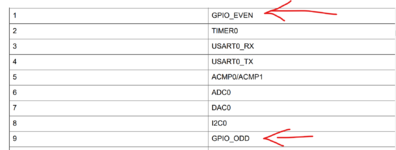yefj
Advanced Member level 5

Hello ,in the example shown bellow our interrupt is defind as
GPIO_ExtIntConfig(BSP_GPIO_PB0_PORT, BSP_GPIO_PB0_PIN,BSP_GPIO_PB0_PIN, 0, 1, true);
BSP_GPIO_PB0_PORT=gpioPortF
BSP_GPIO_PB0_PIN=6
The intersting part comes for the intNo parameter we put BSP_GPIO_PB0_PIN which is six so we set it to be interrupt number 6.
Interrupt number 6 is RAQ_seq_irq ,maybe there is a mistake in the example?
What is the logic when defining intNo parameter of the interrupt.
Thanks.
Interrupt notes:


GPIO_ExtIntConfig(BSP_GPIO_PB0_PORT, BSP_GPIO_PB0_PIN,BSP_GPIO_PB0_PIN, 0, 1, true);
BSP_GPIO_PB0_PORT=gpioPortF
BSP_GPIO_PB0_PIN=6
The intersting part comes for the intNo parameter we put BSP_GPIO_PB0_PIN which is six so we set it to be interrupt number 6.
Interrupt number 6 is RAQ_seq_irq ,maybe there is a mistake in the example?
What is the logic when defining intNo parameter of the interrupt.
Thanks.
Interrupt notes:
Code:
/***************************************************************************//**
* @file main_s1.c
* @brief This project demonstrates a using GPIOs to trigger external
* interrupts. When PB0 or PB1 is pressed, LED0 or LED1 is toggled,
* respectively. See readme.txt for details.
*******************************************************************************
* # License
* <b>Copyright 2020 Silicon Laboratories Inc. www.silabs.com</b>
*******************************************************************************
*
* SPDX-License-Identifier: Zlib
*
* The licensor of this software is Silicon Laboratories Inc.
*
* This software is provided 'as-is', without any express or implied
* warranty. In no event will the authors be held liable for any damages
* arising from the use of this software.
*
* Permission is granted to anyone to use this software for any purpose,
* including commercial applications, and to alter it and redistribute it
* freely, subject to the following restrictions:
*
* 1. The origin of this software must not be misrepresented; you must not
* claim that you wrote the original software. If you use this software
* in a product, an acknowledgment in the product documentation would be
* appreciated but is not required.
* 2. Altered source versions must be plainly marked as such, and must not be
* misrepresented as being the original software.
* 3. This notice may not be removed or altered from any source distribution.
*
*******************************************************************************
* # Evaluation Quality
* This code has been minimally tested to ensure that it builds and is suitable
* as a demonstration for evaluation purposes only. This code will be maintained
* at the sole discretion of Silicon Labs.
******************************************************************************/
#include "em_device.h"
#include "em_chip.h"
#include "em_cmu.h"
#include "em_emu.h"
#include "em_gpio.h"
#include "bsp.h"
/**************************************************************************//**
* @brief GPIO Even IRQ for pushbuttons on even-numbered pins
*****************************************************************************/
void GPIO_EVEN_IRQHandler(void)
{
// Clear all even pin interrupt flags
uint32_t res;
res=GPIO_IntGet();
GPIO_IntClear(0x5555);
// Toggle LED0
GPIO_PinOutToggle(BSP_GPIO_LED0_PORT, BSP_GPIO_LED0_PIN);
}
/**************************************************************************//**
* @brief GPIO Odd IRQ for pushbuttons on odd-numbered pins
*****************************************************************************/
void GPIO_ODD_IRQHandler(void)
{
// Clear all odd pin interrupt flags
GPIO_IntClear(0xAAAA);
// Toggle LED01
GPIO_PinOutToggle(BSP_GPIO_LED1_PORT, BSP_GPIO_LED1_PIN);
}
/**************************************************************************//**
* @brief GPIO initialization
*****************************************************************************/
void initGPIO(void)
{
// Enable GPIO clock
CMU_ClockEnable(cmuClock_GPIO, true);
// Configure PB0 and PB1 as input with glitch filter enabled
GPIO_PinModeSet(BSP_GPIO_PB0_PORT, BSP_GPIO_PB0_PIN, gpioModeInputPullFilter, 1);
GPIO_PinModeSet(BSP_GPIO_PB1_PORT, BSP_GPIO_PB1_PIN, gpioModeInputPullFilter, 1);
// Configure LED0 and LED1 as output
GPIO_PinModeSet(BSP_GPIO_LED0_PORT, BSP_GPIO_LED0_PIN, gpioModePushPull, 0);
GPIO_PinModeSet(BSP_GPIO_LED1_PORT, BSP_GPIO_LED1_PIN, gpioModePushPull, 0);
// Enable IRQ for even numbered GPIO pins
NVIC_EnableIRQ(GPIO_EVEN_IRQn);
// Enable IRQ for odd numbered GPIO pins
NVIC_EnableIRQ(GPIO_ODD_IRQn);
// Enable falling-edge interrupts for PB pins
GPIO_ExtIntConfig(BSP_GPIO_PB0_PORT, BSP_GPIO_PB0_PIN,BSP_GPIO_PB0_PIN, 0, 1, true);
GPIO_ExtIntConfig(BSP_GPIO_PB1_PORT, BSP_GPIO_PB1_PIN, BSP_GPIO_PB1_PIN, 0, 1, true);
}
/**************************************************************************//**
* @brief Main function
*****************************************************************************/
int main(void)
{
// Chip errata
CHIP_Init();
// Initializations
initGPIO();
while (1){
// Enter Low Energy Mode until an interrupt occurs
EMU_EnterEM3(false);
}
}

